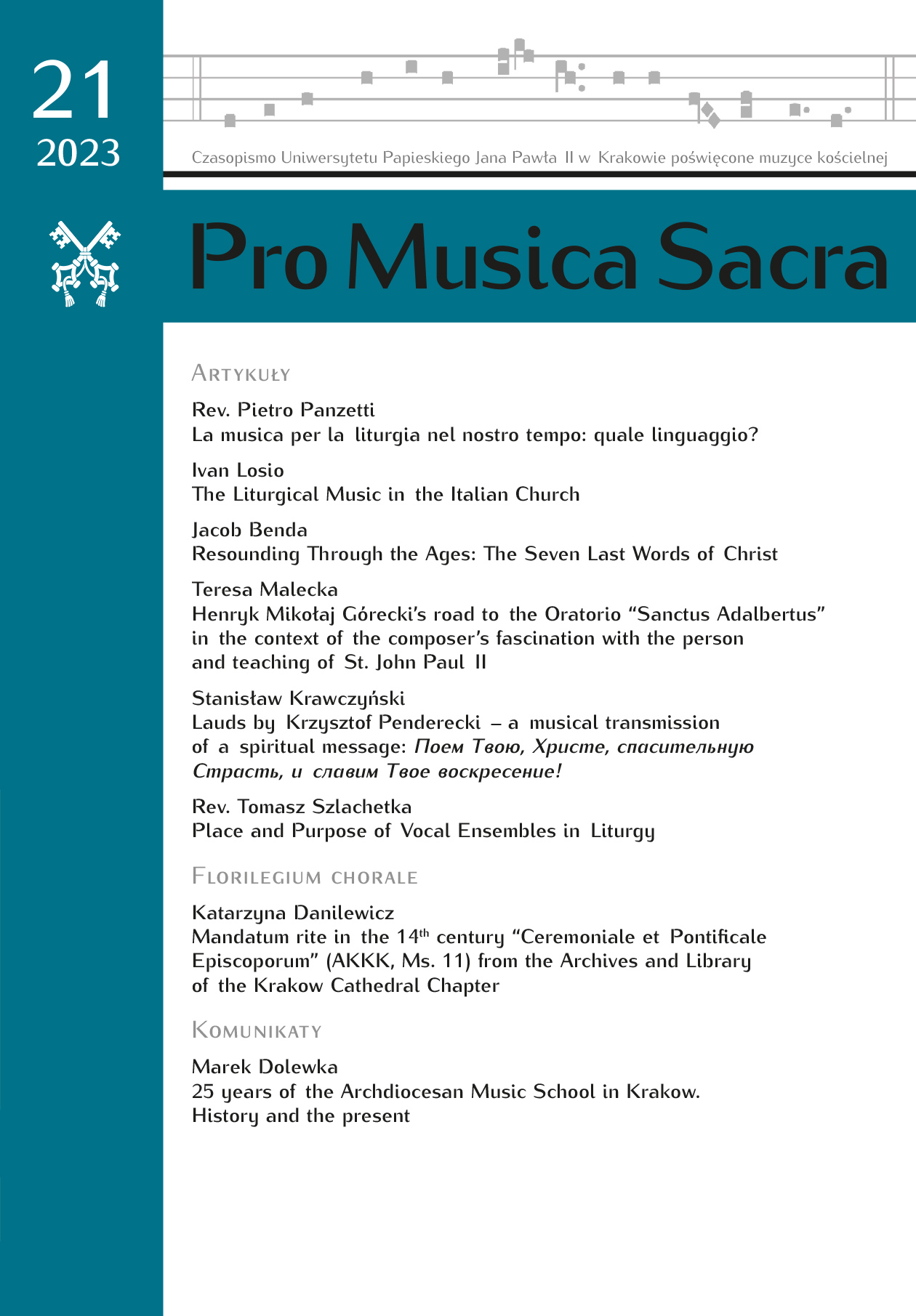The Liturgical Music in the Italian Church
DOI:
https://doi.org/10.15633/pms.2102Keywords:
Functionality, word, forms, repertoire, rituality, training, compositionAbstract
The modern era of liturgical music in the Church in Italy has favored a situation in which a multiplicity of languages, styles and genres that probably characterize its uniqueness in the world scene coexist. We certainly cannot say that we live such a happy era from this point of view. After almost 60 years in which a false concept of liturgical creativity has been operating almost undisturbed, we are faced with an immense variety of situations within which – even in the presence of virtuous and significant experiences – a sort of generalized mediocrity is imposed which is almost all The cornerstones dictated by tradition and redefined by Vatican II. It is more than ever necessary to rediscover some fundamental concepts: the functionality of liturgical music; the music that wears the word; musical forms; the
choice of the repertoire; the need for training; The task of the liturgical music composer.
References
Baroffio G., Singing and music in Christian worship, in: Elements of liturgical musicology, Pontificio Istituto di Musica Sacra, Rome 2016.
Cardini F., Music is also a symbol, in: Elements of liturgical musicology, Pontificio Istituto di Musica Sacra, Rome 2016.
Council of Trent, Conciliar Constitution De observandis et vitandis in celebratione Missae, 1562.
Second Vatican Council, Conciliar Constitution Sacrosanctum concilium, 1964.
Gelineau J., Song and Music in Christian Worship – principles, laws and applications, LDC, Turin 1963.
Gelineau J., The chants of the Mass in their ritual roots, Ed. Messaggero, Padua 2004.
John XXII, Bull Docta sanctorum patrum, 1322.
Miserachs Grau V., Composing for the ritual between problems of functionality and artistic needs, speech at the Conference entitled “The composition of music for the liturgy at the beginning of the new millennium”, Italian Association of Santa Cecilia, September 1–3, Rome–Vatican City 2017.
Rainoldi F., Traditio Canendi – Notes for a history of Christian rites, Centro Liturgico Vin cenziano Edizioni Liturgiche, Rome 2000.
Rainoldi F., Psallite wiser – historical liturgical notes and pastoral reflections on the chants of the Mass and the Liturgy of the Hours, Centro Liturgico Vincenziano Edizioni Li turgiche, Rome 2008.
Rampi F., Hymns for the liturgical assembly, Elledici, Turin 2013.
Saint John Paul II, Chirograph for the centenary of the Motu Proprio Inter sollicitudines, 2003.
Saint Pius X, Motu Proprio Inter sollicitudines, 1903.
Downloads
Published
Issue
Section
License

This work is licensed under a Creative Commons Attribution 4.0 International License.
Authors who publish with this journal agree to the following terms:
- Authors retain the copyright and full publishing rights without restrictions, and grant the journal right of first publication with the work simultaneously licensed under a Creative Commons Attribution 4.0 International License that allows others to share the work with an acknowledgement of the work's authorship and initial publication in this journal.
- Authors are able to enter into separate, additional contractual arrangements for the non-exclusive distribution of the journal's published version of the work (e.g., post it to an institutional repository or publish it in a book), with an acknowledgement of its initial publication in this journal.
- Authors are permitted and encouraged to post their work online (e.g., in institutional repositories or on their website) prior to and during the submission process, as it can lead to productive exchanges, as well as earlier and greater citation of published work (See The Effect of Open Access).

